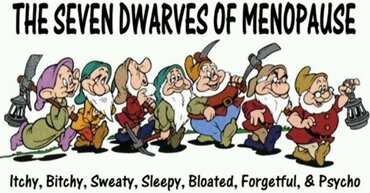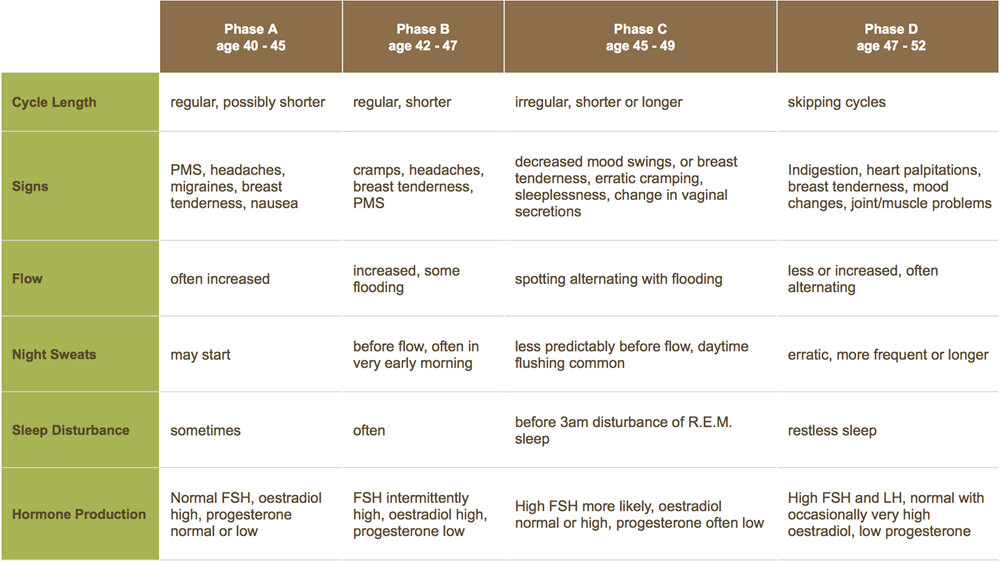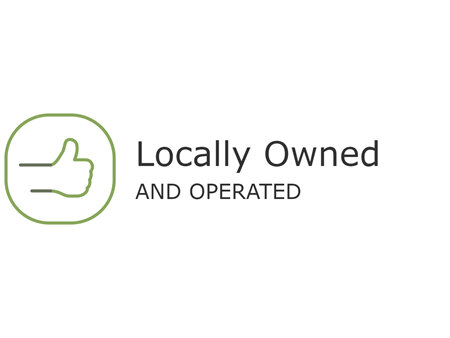Summary: “Perimenopause is made up of five phases...The phases may overlap and we may have all or few of the changes indicated. By comparing changes to those in the chart, each of us can identify key issues and have some idea of the duration of these signs...Rarely do these changes persist as problems in later life but typically improve after menopause.”
What do we do?
In summary:
- We want to encourage ovulation for as long as we’re going to ovulate, for the benefits of progesterone.
- We want the benefits of oestrogen, but not the detriments of too much oestrogen (see oestrogen detox).
- Taking care of our thyroid and adrenal glands as well as our digestion and liver will certainly help all of the above.
- Nutrients, diet, lifestyle and possibly herbs and/or hormones can all help during this time...
Lifestyle considerations
These are mostly related to ridding of excess oestrogens and/or encouraging progesterone production and supporting digestion, the adrenal glands and thyroid.
What you eat, exercise, avoiding environmental oestrogens, and stress reduction will have a HUGE impact on this balance, which may improve PMS, perimenopause and menopause symptoms… as well as help to prevent cardiovascular disease, type II diabetes etc.
The general consensus is that perimenopause (and related oestrogen related problems such as cancers) is getting worse and is much more prevalent in “western world” countries. If we didn’t have pesticides, hormones in our meat, soft plastics etc. we wouldn’t be exposed to as many compounds, which act like oestrogen. We also eat too little fibre and too many bad fats and processed foods. Then, stress doesn’t help our body to cope with hormone changes, on top of that. Many suggest a genetic component, but take a Japanese woman out of Japan, modify her diet and lifestyle from her traditional way and suddenly she may experience perimenopause too.
Oestrogen Detox: helps problems associated with hormone imbalance problems as well as help protect from potential harm such as cancer.
- Fibre: Intestinal Clean Out!!! Takes oestrogens away before they can be reabsorbed.
-LSA (ground Linseed, Almond and Sunflower seeds, kept fresh in fridge/freezer) is an excellent daily addition to your diet (add to smoothie)
-Fibre + Probiotics + Good oil (omega 3 fish oil) = happy digestion (so you can absorb the nutrients from your good food, as well as get rid of the unneeded waste effectively)
- Probiotics are an important part of supporting excretion of used hormones. They can also assist with symptoms such as bloating and bowel disturbance related to the cycle.
- B-Vitamins – often called the “stress vitamins,” they are also helpful for improving PMS symptoms, preventing heart disease and oestrogen related problems (helps oestrogen detox) . Some sources: whole, “unrefined” grains and many fruits and vegetables
- Di-indole methane improves ratio of good to “bad” oestrogen. Found mainly in cabbage, broccoli, cauliflower, brussel sprouts, bok choy (should be cooked), but also mustard greens and kale. You can also supplement with di-indole methane (DIM) capsules if there is a strong family history of breast cancer etc.
- Sulphur containing foods are helpful for ridding “bad oestrogen” from the body. Mostly from proteins in diet. Foods include onions, garlic, meat, eggs. Not the sulphur found in processed foods.
- Environmental oestrogens: very difficult to avoid but being aware, so you can lessen exposure, without creating paranoia, is easy. In general;
wash fruits and veggies (organic would be ideal)
use harder plastics when needed
avoid heating plastics and cool food before putting them into plastic containers
don’t use petroleum based products (body creams are a big one)
General Health Tips:
- Plan meals ahead and plan for 3:00pm crash, if you experience them. Nuts, smoothie…
- Blood sugar regulation is life saving in the long run (google Metabolic Syndrome). Following the Basics and avoiding highs and lows in blood sugar, by mixing protein, good fats and good carbs over the day will help pretty much every area of health.
- Reduce caffeine (especially if causes anxiety etc)
- Get rid of addictions
- Low Stress Diet: Low stress on the body, therefore diet low in processed, allergenic, chemical afftected, hard to digest foods. Drink the bulk of fluids away from meal times, so digestive juices aren’t diluted. Great basic article: http://www.drfrances.co.nz/low-stress-diet.html
- Confection vs Nutrition: You can tell me it’s low fat, low carb, low calorie…but, is it nutritious??? Is it full of sugar, artificial sweetener, colours? Coffee/tea/alcohol may be ok for some, but moderation is key.
- Eat sitting down and CHEW. Food is not digested well if you eat on the run, don’t chew properly or you are feeling stressed. Turn off the TV and enjoy your food and the people eating with you.
- Digestion must be addressed. Most of us could use a course or regular use of probiotics, let alone if you’ve had a course of antibiotics, tummy bug, stress etc. Probiotics are the friendly bacteria needed for digeston. Our digestive tract is also a major part of our immune system, so vital for general health.
- Our digestive system needs to be healthy to absorb essential nutrients. Food intolerances and acid reducing medicines decrease digestive function. Nutrients are depleted by stress, bad digestion etc. let alone what we eat/drink eg. Coffee depletes magnesium. Sugar depletes vitamin C. Not saying not to drink coffee ( because I DO believe it can be good for you and drink it myself)…but moderation and get the nutrient balance.
- Fibre, proper portions of (chewed) protein, vegetables, good carbs and fats “ferment” and breakdown in the stomach to help good bacteria grow and aid digestion. What are your stools like? Not too hard/soft/smelly/undigested food?
- Figure out food/additive intolerances and avoid them as much as possible. Many people are on acid reducing drugs instead of figuring out an intolerance or building up the gut health to properly digest again. We need acid for digestion. Sometimes these medicines were prescribed for an ulceration, but once you have healed they can be reduced and then stopped while being monitored.
Protein: Don’t forget protein throughout the day.
Eat a serving of protein at every meal and snack. Protein has an important role in maintaining the stabilisation of your blood sugar. A serving of meat is what you can fit in the palm of your hand.
Remember: vegetarians need to mix proteins to make a complete protein, therefore mix two out of three of; nuts/seeds, or beans or brown rice.
Generally aim for 30% of total diet:
1 gram/kg ideal body weight per day (kids and athletes should have 1.25-1.5g/kg)
100g = example palm size serving (these are all approximate guide lines)
Examples of approximate protein values:
1 egg = 7g protein (eggs are so great for you…ignore old myths…two a day is very ok)
1 palm of:
- red meat = 30g protein
- chicken = 22g protein
- fish = 20g (if fatty, then Omega 3!!! for brain/heart/antiinflammatory etc. too)
- beans = 10-15g protein
- nuts/seeds = 10g protein
A Smoothie can be a great source of protein, nutrients and fibre:
eg. Whey protein or high quality legume/rice protein, LSA (ground linseed/almond/sunflower fresh from fridge/freezer), frozen blueberries and banana to start, then whatever you want to add at time…spirulina or greens powder, drops (vit d, zinc, selenium, zinc), powder vitamins like vitamin C etc. Speed up the process by keeping a mix in fridge (protein powder(s) plus LSA etc)
Fats: Good Fats are so good for you and add flavor and satisfaction to meals/snacks.
- Omega 3’s. Such as: oil fish (salmon, sardines, anchovies, mackeral), nuts and seeds (raw almonds, sunflower and pumpkin seeds) . Eat fresh fish 2-3 times a week. Take fish oil supplements.
- Plant oils such as avocado and/or olive oil. Only buy cold pressed oils, preferably in dark bottles and stored properly. Do not use for cooking. Eat 2 tablespoons per day. Eat avocado and olives.
- Eat saturated fats in the form of butter (or ghee), coconut oil and ORGANIC animal sources. (10% of your total fat intake should be in the form of saturated fat.
Carbohydrates: Eat “good carbs” in moderation. The Glycemic Index (Low GI) Diet helps, to start (but still think about nutritious vs confection…gluten in excess doesn’t agree with most of us)
- Enjoy all types of fruit and vegetables.
- Aim for 5-6 servings of vegetables a day. Eat them at every meal, not just dinner. Vegetables should take up half your dinner plate. Root vegetables are an important source of carbohydrate.
- Eat 2-4 servings of fruit a day. Eat throughout the day, not in one sitting. (fruit is only part of a snack.
- Eat plenty of salad vegetables with vinaigrette dressing (make your own dressing; cold pressed olive/safflower/flax oil plus apple cider vinegar, garlic and lemon)
- Eat legumes and beans. (throw them in everything to decrease your food bill too).
- Eat Whole grains (as you tolerate). Avoid white foods including rice. Whole grains include wholemeal flour, brown basmati rice, oats, quinoa, aramanth and millet.
Lifestyle:
Exercise: DO IT…decreases stress, great for heart, bones…Sometimes it is best to get basics dealt with first, to then have energy for exercise; iron, B vitamins, zinc, omega 3…
Burst exercise is being proven to benefit. Work hard then rest. Repeat.
Example: Four Exercises – Get heart pumping then rest (feel the burn) – Repeat
1) Dips – back to chair with hands on chair and dip bum down and up
2) Bum to seat (not controlled fall) then cross legs
3) Prone hold on chair or floor
4) Chest – press ups on chair or wall press ups
Walking is still great. Trying running between lamp posts (or until feel the burn, then rest).
Stress Reduction may be easier said than done, but must be addressed. If your answer is a book, walk, or yoga or a combination, please make the time. The pay off will be more energy and better health, in the long run.
Stressing about food and/or exercise, is a major societal source of stress. And often ends with the opposite of the desired effect on the body.
We need some time in a “quiet room.” We know it, but try to step outside and take a breath. Even 30 seconds. We need to feel like not everything is a threat.
Breathe – work on deep, effective breathing. Really.
Sleep – make it a priority to improve sleep quality and wake rested. The suggestions on ths handout can help. 5HTP sleep aid products help with the “mind buzz” but may interact with antidepressants, so then focus on adrenal feeding, magnesium etc.
We could stop here and make significant improvements to overall wellbeing…
Specific Nutrients:
Vitamin D
Now recognized as an issue in New Zealand, but many still don’t believe it. We wear sunscreen and cover up (our sun is harsh), the darker you get the more sun you need, we have to carry our stores through the winter…
Anyone with pains, blood sugar or immune system issues should consider looking at their vitamin D status.
I’m not saying not to protect your skin, but we need some unprotected sun exposure without burning…or supplement.
Facts:
- Reduced fracture risk when used with calcium
- Helps gut motility (eg bloating…also think about zinc)
- Protection against diabetes (insulin resistance) and cardiovascular disease
- Reduces total mortality (which in developed countries has a large cardiovascular component)
- Immune system effects including reducing risk of multiple sclerosis, rheumatoid arthritis and type 1 diabetes
- Plays a role in protection against colon, breast, ovarian and prostate cancers.
- Helps chronic pain including unexplained bone and/or muscle pain.
- blood test at least 100nmol/L – cost to patient of $42. If low, boost with high dose first then maintain.
- Food sources: oily fish, butter, eggs and fortified foods.
Zinc
Zinc is often though about with regards to skin and fertility, but it is necessary for 100’s of functions in the body. It is also lacking in New Zealand soils (along with selenium and iodine – our poor thyroids!)
If you have blood sugar issues, your food is lacking taste, skin issues, allergy, immune system, mood, digestive or thyroid issues, you must consider looking at your zinc status.
Facts:
- lacking in New Zealand soils. Women require a minimum of 15mg and men 30mg daily
- low zinc and/or high copper can lead to flushing, red face, discolour of skin, tachycardia
- low zinc can lead to craving wrong foods eg carbohydrates (also consider chromium), sugar, alcohol
- low zinc can contribute to new allergy-like symptoms and result in lowered white blood cells on blood test which is a sign of our immune system status. Zinc plays a part in fighting viral infections.
- Zinc improves skin healing. Hormone pattern acne outbreaks can be helped by zinc, because it helps keep improve testosterone levels rather than hormones that are negative to skin. Improving testosterone improves energy, libido, bones etc.
- Zinc helps thyroid, is an antioxidant and can help anxiety/mood
- Zinc helps production, storage and release of insulin
- Food sources: richest sources are animal based foods; oysters, beef, chicken, turkey and dairy. Plant based foods are chickpeas, peanuts and almonds depending on soil quality
- White lines on nails can be symptom of deficiency
Try a simple zinc test in pharmacy (swish solution in mouth). Blood tests can be done, but must be paid for. Drink test, plus symptom monitoring can be adequate/safe management
Both Vitamin D and Zinc are funded by Pharmac by prescription. I wish magnesium was too.
Magnesium
Magnesium is such an essential nutrient for all of our muscles (including heart), oestrogen detoxification and helps many aspects of PMS, perimenopause and menopause. A high percentage of the general population doesn’t consume the RDA (recommended daily allowance) of magnesium, so noting magnesium foods and ways to avoid depletion are essential. We need at least 250mg daily.
- Food sources are primarily dark leafy veggies as well as nuts, seeds and grains.
- depleted by coffee, stress and alcohol– obvious signs of depletion can be eye twitch and muscle cramps, but also hot flushes, migraines and anxiety
- Stress and coffee cause our body to process and rid magnesium faster, leading to depletion.
- can help hot flushes, feed adrenals (immune/stress glands), Migraine, anxiety/mood, sleep, carbohydrate cravings (also zinc), and aid healthy cholesterol
- improves insulin sensitivity (better for blood sugar control)
- Depleted by coffee and stress (after coffee, 4x more magnesium in urine…are those palpitations from the caffeine or the lack of magnesium?)
- Can dose to bowel tolerance, but at least 250mg daily.
- 200mg per day can improve painful periods and fluid retention
- check out http://ods.od.nih.gov/factsheets/Magnesium-HealthProfessional/ for a very interesting read. I challenge everyone to add up your daily magnesium intake.
Chromium
Helps blood sugar regulation by helping insulin work properly. Blood sugar “crashes,” sugar cravings and hunger irritability (and resultant weight gain and susceptibility to diabetes) can be helped by chromium. Common dosing is 200mcg twice daily.
or wean off the sweet need. Take Chromium 500mg twice daily for 2-3 weeks if needed.
Iodine
- Not found (or minimal) in NZ soil and we require at least 200mcg a day
- Helps thyroid, oestrogen detox, fibrous tissue breakdown (breast, fibroid)
- Salt is not the best source. sea vegetables and/or some kelp (nori, kombu, wakame), are good sources. Choose iodised sea salt over table salt.
- doses needed to breakdown fibrous tissue (uterine fibroid or breast) are much higher than a multivitamin. Lower doses will still aid thyroid and help oestrogen detox. High dosing: Lugols iodine drops 1 to 2 drops in water daily (tablets also available but not as economical). Ensure full thyroid test including antibodies to ensure iodine supplementation appropriate
- See http://www.drfrances.co.nz/about-iodine.html for a nice article
Vitamin C
- is cheap and a great antioxidant to add in to most people’s basic nutrition.
- It can be increased as tolerated when you feel sickness coming on (loose stool is the guide to lower dose) and slowly decreased back down to what you take on a daily basis.
- we now know vitamin C is more than just a cheap antioxidant!! Important for tissue formation, wound healing, mood, energy, cell response to stress, hormone synthesis (serotonin in the brain), important for everyday chemical reactions in body…
- Dose: 1000mg or more per day. 2 kiwi fruit per day (even cold stored) can achieve basic levels in a well person.
- Vitamin C may help hot flushes (presumably by feeding the adrenal (stress and immune) glands.
Vitamin E
- Economical antioxidant also shown to aid flushing, depression, anxiety and vulvovaginitis.
- Improves glucose disposal
- Mixed tocopherols including Gamma (never synthetic and not just d-alpha tocopherol). Dose: 400-800IU per day
Selenium
From drfrances.co.nz/is-your-selenium-adequate.html : Selenium is a metallic antioxidant – it stops things going ‘rancid’ in your body or oxidizing. It does this because it is associated with the most important antioxidant of them all – Glutathione. This prevents free radical build up and consequent cancer and disease.
Apart from Brazil nuts (by far the most abundant source), other sources include wheat germ, whole grain bread, barley, eggs, mushrooms, legumes, liver, kidneys, rabbit, chicken, herring, shellfish, asparagus, cabbage, garlic, onions, radish, tomatoes, etc. (drfrancis.com)
Laws in other countries limit selenium content, which New Zealanders require due to lack in soils. Low dosing will still aid thyroid and give some antioxidant action, but dosing can go up to 200mcg daily. Two to four brazil nuts (from Brazil) daily should provide the approximate daily requirement of selenium, not found in NZ soils).
Essential Fatty Acids
Omega 3 Fish Oil (high DHA and EPA)
- So great for many body functions (brain (mood, memory), blood vessels, joints (inflammation)...). Most of us would benefit from a high quality fish oil supplement.
- Increases insulin sensitivity, fat burning, prevents insulin resistance in diabetes and obesity
- Decreases C-Reactive Protein (CRP) one of the markers of inflammation
- Our high omega 6 diet further throws off an ideal healthy balance of omega 3.
Dose: 1 teaspoon daily high quality Cod Liver Oil (eg.Nordic Naturals), or equivalent capsule choice.
Omega 6 (if needed)– The best choices are gamma-linolenic acid sources (not as effected by dietary insufficiencies, so get more activity as result) choices such as Evening Primrose or Borage. May aid PMS symptoms.
A few Herbs:
Women’s Herbal Tonic (practitioner only) – great for feeding the adrenals as well as:
Rehmannia (hot flushes), Withania (anxiety/insomnia), Rhodiola (stress/fatigue/sleep/mood)
Allow 6 weeks to work, but often notice a difference much earlier, especially if taken with nutrients. When hot flushes occur during menopause (no period for at least a year) women are often given no options, but feed the adrenals and flushes may be alleviated.
Not suitable for complete adrenal burn out, because we don’t want to decrease the already low cortisol levels at which case you would work with nutrients, decreasing all stresses and a herbalist if you choose herbs. (Rhodiola is definitely ok).
Chaste Tree herbal remedy (Vitex agnus-castus) can be taken to help stimulate your body to ovulate, thus helping to increase progesterone production. Eg. Mediherb tablets: 2 tablets daily
Black Cohosh German Commission E has listed black cohosh use for menopausal symptoms for decades. It appears to have an adapting action, so competes with too much oestrogen and fills in the gaps with too little. My experience has been that it either works or doesn’t (within 4-6 weeks). When it works it does so for 6 months to 2 years and then it doesn’t anymore.
Hormones - Usual Basic Hormone Choices – if necessary:
Progesterone:
- Perimenopause: Periods tell us oestrogen is present, therefore our aim is to increase progesterone levels to help balance oestrogen highs and lows, as well as for its own benefits for hot flushes, sleep quality, calming etc. Cyclic Progesterone (prescription) as cream 20mg twice daily or as capsule (compounded in oil) 100-200mg at bedtime for days 14 to 27 of cycle. (see handout)
- Menopause: No period usually means both progesterone and oestrogen are low. Progesterone is safe and helpful to all other hormones, and usually the first hormone to be low,(depending on symptoms, of course). Dose: 20mg twice daily as a cream or 100-200mg in oil capsules at bedtime. Use everyday for 3 months, then reassess.
Testosterone: can be confusing to know if it is high/low testosterone, so ensure you address zinc, progesterone production, feeding the adrenals, blood testing etc first. You may just be able to improve testosterone levels and effectiveness yourself.
Oestriol Vaginal Cream (Ovestin): For vaginal dryness, thinning, susceptibility to infection. Funded safest oestrogen option. Very little (if any) turns to the less desirable oestrogens. Use daily for 2 to 3 weeks to achieve results, then use a few times per week to maintain.
Thyroid and Adrenal Glands
Thyroid Gland
The thyroid gland is a butterfly-shaped organ located in the front of the neck. Its main function is to produce thyroid hormones which control the body's metabolic rate (metabolism).
Our thyroid gland Needs zinc (oysters, meat, eggs, seeds), selenium (brazil nuts) and iodine (seafood) – all lacking in NZ soils and take effort to get from food.
TSH blood test states a range of 0.27 - 4.2 mIU/L. Most practitioners consider 2-4.2 subclinical hypothyroid and prefer a reading of
See great article by Dr Frances Pitsilis : http://www.drfrances.co.nz/underactive-thyroid.html
“A zinc deficiency causes lowered production of TSH from the pituitary.”
“Increased stress causes suppression of TSH from increased release of cortisol from the adrenal glands, and release of another messenger, CRF (Corticotrophin Releasing Factor) from the hypothalamus.”
“In women, hypothyroidism is associated with menstrual irregularities, absence of ovulation, and infertility.”
Oestrogen excess and Thyroid – Dr George Gillson (referred to above…oestrogen increases Thyroid Binding Globulin, so thyroid hormone is there, but bound so can’t act properly)
“There is a close relationship between oestrogens and thyroid hormone. Basically, excess oestrogens suppress the action of thyroid hormone. Many women have normal thyroid tests but show signs and symptoms of low thyroid. This is called a functional deficiency. Progesterone can assist the action of thyroid hormones, and so excess oestrogens, low progesterone and symptoms of low thyroid hormone often run together, while thyroid labs tests are usually normal.”
Adrenal Glands
- Walnut sized glands that sit on top of the kidneys
- Play a major role in glucose, sodium and potassium regulation
- Amongst others, produces adrenaline, cortisol, DHEA, oestrogen, progesterone and testosterone (our major hormone source in menopause)
- Our fight or flight centre – not designed for daily unrelenting stress
- DHEA goes down first, our most abundant adrenal hormone and source for sex hormones. Then, cortisol lowers and raises in all the wrong places – contributes tired mornings, wired nights, coping with stress, hot flushes and fat distribution
- Recovery takes time but best to catch before burn out, identify stresses and build system with healing lifestyle
- DHEA Blood test costs (~$50?). With morning cortisol, this can give an idea of adrenal function.
- Feed the adrenal glands with b-vitamins, magnesium, vitamin C, zinc, certain herbs and giving them a rest (decreasing stress)








